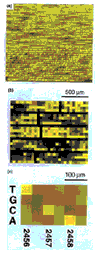Applications of microarray technology in breast cancer research
- PMID: 11305951
- PMCID: PMC138681
- DOI: 10.1186/bcr291
Applications of microarray technology in breast cancer research
Abstract
Microarrays provide a versatile platform for utilizing information from the Human Genome Project to benefit human health. This article reviews the ways in which microarray technology may be used in breast cancer research. Its diverse applications include monitoring chromosome gains and losses, tumour classification, drug discovery and development, DNA resequencing, mutation detection and investigating the mechanism of tumour development.
Figures






References
-
- Bassett DE, Eisen MB, Boguski MS. Gene expression informatics - its all in your mine. Nat Genet. 1999;21 (suppl):51–55. - PubMed
-
- Ramsay G. DNA chips: state-of-the-art. Nat Biotechnol. 1998;16:40–44. - PubMed
-
- Chee M, Yang R, Hubbel E, Berno A, Huang XC, Stern D, Winkler J, Lockhart DJ, Morris MS, Fodor SP. Accessing genetic information with high-density DNA arrays. Science. 1996;274:610–614. - PubMed
-
- Lockhart DJ, Dong H, Byrne MC, Follettie MT, Gallo MV, Chee MS, Mittman M, Wang C, Kobayashi M, Horton H, Brown EL. Expression monitoring by hybridisation to high-density oligonucleotide arrays. Nat Biotechnol. 1996;14:1675–1680. - PubMed
-
- Lipshutz RJ, Fodor SPA, Gingeras TR, Lockhart DJ. High density synthetic oligonucleotide arrays. Nat Genet. 1999;21 (suppl):20–24. - PubMed
Publication types
MeSH terms
Substances
LinkOut - more resources
Full Text Sources
Other Literature Sources
Medical

